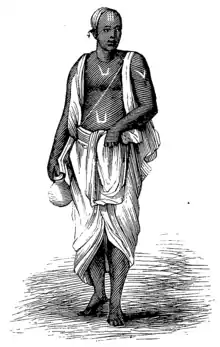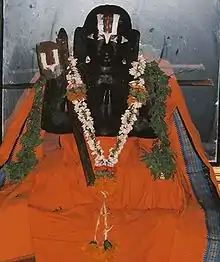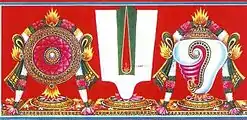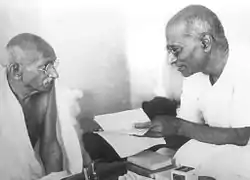Iyengar
Iyengars (also Ayyangars or Aiyengars) ([əjːəŋɡɑːr]) are an ethnoreligious group of Tamil-speaking Hindu Brahmins, whose members follow Sri Vaishnavism and the Visishtadvaita philosophy propounded by Ramanuja. Found mostly in the Indian states of Tamil Nadu and Karnataka, Iyengars are divided into two sects, the Vadakalai and the Thenkalai. As with other Brahmin communities, they are also classified based on their gotra, or patrilineal descent, and the Veda they follow. Iyengars belong to the Pancha Dravida Brahmana sub-classification of Brahmins.
 1855 illustration of an Iyengar with religious symbols on the body and holding a vessel of water in the hand. | |
| Regions with significant populations | |
|---|---|
| India Tamil Nadu, Karnataka, Andhra Pradesh, Telangana . | |
| Languages | |
| Tamil, Kannada, Telugu | |
| Religion | |
| Hinduism (Sri Vaishnavism) |
Etymology
There are several opinions regarding the etymology of the term Iyengar. One is that Iyengar derives from the word ayya-garu, which became ayyangaaru, and later ayengar. The term "ayya" is the Prakrit version of the Sanskrit word arya which in Sanskrit means noble.[1] Another is that the word ayyangaar was first used by Kandhaadai Ramanuja Ayyangaar of Tirupathi, around 1450 AD.[2]
History
Common origins

The Iyengar community traces its philosophical origins to Nathamuni, the first Sri Vaishnava acharya,[3] who lived around 900 CE. He is traditionally believed to have collected the 4,000 works of Nammalvar and other alvars,[4] the poet-saints of Southern India who were intensely devoted to Vishnu on both an emotional and intellectual plane.[5] The belief is that he set this collection - commonly called the Tamil Prabhandams - to music,[4] and he introduced the devotional hymns of the alvars into worship, thus mixing their Tamil Veda with the traditional Vedas written in Sanskrit. A scriptural equivalence was accepted by the community that formed from his works. The Sanskrit texts are considered to be metaphysical truth and the Tamil oral[3] variants to be based on human experience of the same.[6] This community became immersed in the dual-language worship in temples where issues of caste were of no concern.[3]
A century or so later, Ramanuja became the principal amongst religious leaders who formalized the efforts of Nathamuni as a theology.[3] Ramanuja developed the philosophy of Visishtadvaita and is described by Harold Coward as "the founding interpreter of Sri Vaisnavite scripture,"[5][lower-alpha 1] while Anne Overzee says that he was a collator and interpreter rather than an original thinker. Although showing originality in his method of synthesizing the Tamil and Sanskrit sources,[8] Ranjeeta Dutta said that the two sets of sources "continued to be parallel to each other and not incorporative" at this time.[3]
Nathamuni and Ramanuja were both Brahmins, while Nammalvar was of the Vellala community. All three men were Tamils,[lower-alpha 2] although Ramanuja documented his thoughts in Sanskrit.[11]
Schism


Ramanuja was initially a proponent of the traditional bhakti philosophy that demanded adherents have a good command of Sanskrit texts and a ritualized approach to life and devotion. This outlook marginalized women and members of the Shudra Varna because they were disbarred from learning the Sanskrit Vedas. Ramanuja later changed his position and became more receptive to a more inclusive theory.[12] His thoughts also contained what John Carman has described as a "significant ambiguity", of which Ramanuja may not himself have been aware. His metaphorical devices suggested that devotion through ritual "earned" salvation but also that salvation was given through the grace of God.[13] Subsequently, some time around the fourteenth century, the Iyengar community divided into two sects.[14] Both sects maintained a reverence for his works[15] but were increasingly divided due to the doctrinal uncertainties evident in them.[13]
The Vadakalai sect is referred to as the "Northern" culture or school, and the Thenkalai sect is the "Southern" culture or school. These cultures reference the perceived prominence given by the sects to the terse style of Sanskrit traditions and the lyrical Tamil Prabhandams, respectively. S. M. Srinivasa Chari believes this linguistic differentiation to be overstated. The Vadakalai favour Vedanta Desika as their acharya and the Thenkalai prefer instead the teachings of Manavala Mamuni. Chari notes that the sects share a common allegiance to Nammalvar and Ramanuja and that their subsequent significant thinkers "wholly accepted the authority and importance" of both linguistic styles.[15][lower-alpha 3] Harold Schiffman says that the linguistic schism reflects wider underlying doctrinal differences between the populist southern school and the social conservatism of the north, with Tamil historically being a language understood by the masses while Sanskrit was elitist and caste-bound.[17]
Vedic philosophy holds that the supreme goal in life is to attain the blissful state of Brahman through moksha, being the process of liberation of the suffering soul from the cycle of reincarnation.[18] Although eighteen points of difference between the two Iyengar sects are generally recognised, being referred to as the ashtadasa bhedas,[16] most of these are minor.[19][lower-alpha 4] Abraham Eraly describes a principal difference, being
... their views on the nature of divine grace - while the Thenkalai holds that devotion is all that is necessary and that god will on his own initiative carry the devotee to salvation, like a cat carrying a kitten, the Vadakalai holds that man has to win god's grace through his efforts and he has to cling on to god, like an infant monkey clinging on to its mother.[20]
Coward considers this to be the difference between the two schools of thought,[12] and Carman says that "... both [sects] accord primacy to divine grace, but one group feels it necessary to insist that there is no human contribution at all to the attainment of salvation."[21] These variations in interpretation of the nature of prapatti – loosely translated "self-surrender to god"[16] – are called marjara nyaya and markata nyaya, referring to the young of cats and monkeys. They give rise to another naming convention for the two sects, being the "monkey school" and the "cat school".[22]
Unlike the Vadakalai, the Thenkalai Iyengar sect reject the caste system[23] and accepted those of lower castes into their temples. The sect was founded by Pillai Lokacharya.[24]
Vadakalai Iyengars believe that it is necessary to offer obeisance/prostration to God multiple times, while Thenkalai Iyengars believe that it is enough if you offer obeisance/prostration to God once. This is the reason why a Vadakalai Iyengar is often seen prostrating four times, while Thenkalai Iyengars are seen prostrating only once.[25]
Sectarian rivalry
The sectarian rivalry has at times been bitter and, according to Andre Beteille, "aggressive".[26] Thomas Manninezhath notes an intensification of disputes at the time of Thayumanavar in the eighteenth century[27] and on other occasions legal processes have been used in attempts to settle the control of temples.[28]
Relations with other communities
See Also: Criticism of Iyers, Brahminism, Anti-Brahminism, Caste-Based Reservations in Tamil Nadu

Prior to the independence of India, Brahmins had a significant presence in the government posts and education system of Madras province, a part of which is now Tamil Nadu.[29] Since independence, grievances and alleged instances of discrimination by Brahmins in Tamil Nadu are believed to be the main factors which fueled the Self-Respect Movement and marginalised them.[30] This, in combination with the depressed economic and social conditions of non-Brahmins, led the non-Brahmins to agitate and form the Justice Party in 1916, which later became the Dravidar Kazhagam. The Justice Party banked on vehement anti-Hindu and anti-Brahmin propaganda to ease Brahmins out of their privileged positions. Gradually, the non-Brahmin replaced the Brahmin in every sphere and destroyed the monopoly over education and the administrative services which the Brahmin had previously held.[31]
However, with the destruction of Brahmin monopoly over the services and introduction of adequate representation for other communities, anti-Brahmin feelings did not subside. There were allegations of casteism against Brahmins similar to the ones made by the lower castes against them in the decades before independence.
Some Iyengars have worked hard to remove caste-barriers. Sir P. Rajagopalachari, during his tenure as the Dewan of Travancore, introduced legislation to give Dalit and Ezhava children access to schools, despite protests from Malayali upper-castes. He also enabled the lifting of restrictions on the nomination of low-castes and untouchables to the Travancore State Assembly. Chakravarti Rajagopalachari, during his tenure as the Chief Minister of Madras Presidency, enacted a law similar to the Temple Entry Proclamation issued in Travancore that permitted the entry of Dalits into Hindu temples.
There were also accusations that they were Sanskritists who had a contemptuous attitude towards Tamil language, culture and civilisation. Kamil Zvelebil, a Dravidologist, argues from a study of the history of Tamil literature that this accusation is inaccurate and factually wrong. He notes that the Brahmin was chosen as a scapegoat to answer for the decline of Tamil civilisation and culture in the medieval and post-medieval periods.[32]
Subgroups
Hebbar
The details of Hebbar Srivaishnava origin was published long back in the Hebbar Srivaishnava magazine called "Hebbar Kshema". Also, a historical novel was written by Smt. Neeladevi about the life of Ramanuja in Karnataka named "Dhanya", which gives similar answers to the origin of Hebbar Srivaishnavas.
During the time when Ramanuja was in Tondanur (Tonnur) near Melukote, a group of elderly Kannada Brahmins came to Ramanuja and offered to convert to the Srivaishnava religion impressed by Ramanuja's philosophy of Vishistadvaita. Ramanuja affectionately called the group of Hiriya Haruva (elderly Brahmin Kannadigas) as Hebbar and thus originated the sect called Hebbar Sivaishnava (Iyengars). So Hebbar Srivaishnavas are originally Kannada Brahmins (Advaitins) who got converted to Srivaishnavas impressed by the teachings of Sri Ramanuja, and not of backward caste.[33]
Ramanuja asked them to settle in different places of the Hoysala Kingdom (now South Karnataka) and thus one can find many Hebbar Srivaishnavas mainly in the southern districts of Karnataka especially, Bangalore, Mysore, Mandya, Tumkur, Hassan, Kolar and Chamarajanagar districts. Since Kannada was their mother tongue, they still have an affinity with Kannada, but they also speak Tamil.
Mandayam
Mandayam Iyengars are a subgroup of Iyengars, settled in various parts of Karnataka, predominantly Melkote.[34][35] Mandayam Iyengars also speak a different dialect of Tamil called as Mandayam Tamil.[35] Mandayam Iyengars follow Ramanujacharya and Manavala Mamunigal.[36] Mandyam Iyengars do not celebrate the popular Hindu festival of Diwali in remembrance of the day Tipu Sultan massacred close to 1500 men, women and children of this community on Diwali of 1773 in Srirangapatna.[37]
Chelluru
Chelluru Iyengars are a subgroup of Thenkalai Iyengars, settled in various parts of Tamil Nadu, predominantly in Madurai, Sivagangai and Ramanathapuram districts. Chelluru Iyengars follow Ramanujacharya and Manavala Mamunigal. Chelluru Iyengars are believed to have migrated from the Chelluru / Selvanallur village situated in East Godavari District, Andhra Pradhesh around 9th century AD.[38]
Religious observances
A typical Iyengar wedding is made up of the following events: Vethalaipakku, Pandalkal, Janwaasam, Nischayathartham, Jadhaga Naamagaranam, Nandi or Vratham, Kashiyathrai, Oonjal, Piddishuttal, Kanyadaanam, Mangalya Dharanam, Akshathai, Sesha Homam, Saptapadi, Nagoli, Vasthra, Gruhapravesham, Sambandhi Virandhu, Reception, and Nalangu.[39][40]
Notable people
See also
References
Notes
- The traditional biographies of Ramanuja place his life in the period of 1017–1137 CE,[7]
- Nathamuni is thought to have been born at Viranarayana,[9] Ramanuja was born at Sriperumbudur,[7] and Nammalvar at Alvartirunakam.[10]
- S. Dasgupta is quoted by Thomas Manninezhath: "Though the leaders themselves were actuated by a spirit of sympathy with one another, yet their followers made much of these little differences in their views and constantly quarrelled with one another, and it is a well-known fact that these sectarian quarrels exist even now".[16]
- The eighteen sectarian differences are detailed in History of Sri Vaishnavism in the Tamil country (N. Jagadeesan, Koodal Publishers, 1977)
Citations
- Nagendra Kumar Singh (1999). Encyclopaedia of Hinduism, Volume 7. Anmol Publications PVT LTD. p. 898. ISBN 978-81-7488-168-7.
- Lester, Robert C. (1 January 1994). "The Sattada Srivaisnavas". The Journal of the American Oriental Society.
- Dutta, Ranjeeta (September–October 2007). "Texts, Tradition and Community Identity: The Srivaisnavas of South India". Social Scientist. 35 (9/10): 22–43. JSTOR 27644238. (subscription required)
- Overzee, Anne Hunt (1992). The Body Divine: The Symbol of the Body in the Works of Teilhard de Chardin and Ramanuja. Cambridge University Press. p. 35. ISBN 978-0-521-38516-9.
- Coward, Harold G. (2008). The Perfectibility of Human Nature in Eastern and Western Thought. Albany, NY: State University of New York Press. pp. 139–141. ISBN 978-0-7914-7335-1.
- Carman, John B. (1994). Majesty and Meekness: A Comparative Study of Contrast and Harmony in the Concept of God. Wm. B. Eerdmans Publishing. pp. 101–102. ISBN 978-0-8028-0693-2.
- Carman, John B. (1994). Majesty and Meekness: A Comparative Study of Contrast and Harmony in the Concept of God. Wm. B. Eerdmans Publishing. p. 80. ISBN 978-0-8028-0693-2.
- Overzee, Anne Hunt (1992). The Body Divine: The Symbol of the Body in the Works of Teilhard de Chardin and Ramanuja. Cambridge University Press. pp. 30–31. ISBN 978-0-521-38516-9.
- Dasgupta, S. N. (1991). A History of Indian Philosophy. 3. Motilal Banarsidass. p. 94. ISBN 978-81-208-0414-2.
- Sadarangani, Neeti M. (2004). Bhakti Poetry in Medieval India: Its Inception, Cultural Encounter and Impact. Sarup & Sons. p. 28. ISBN 978-81-7625-436-6.
- Carman, John B. (1994). Majesty and Meekness: A Comparative Study of Contrast and Harmony in the Concept of God. Wm. B. Eerdmans Publishing. p. 147. ISBN 978-0-8028-0693-2.
- Coward, Harold G. (2008). The Perfectibility of Human Nature in Eastern and Western Thought. Albany, NY: State University of New York Press. p. 139. ISBN 978-0-7914-7335-1.
The distinction between the two schools is the degree of self-effort or God's grace required for one's surrender to the Lord and release from rebirth."
- Carman, John B. (1994). Majesty and Meekness: A Comparative Study of Contrast and Harmony in the Concept of God. Wm. B. Eerdmans Publishing. p. 95. ISBN 978-0-8028-0693-2.
- Sadarangani, Neeti M. (2004). Bhakti Poetry in Medieval India: Its Inception, Cultural Encounter and Impact. Sarup & Sons. p. 19. ISBN 978-81-7625-436-6.
- Chari, S. M. Srinivasa (1997). Philosophy and Theistic Mysticism of the Alvars. Motilal Banarsidass. p. 244. ISBN 978-81-208-1342-7.
- Manninezhath, Thomas (1993). Harmony of Religions: Vedanta Siddhanta Samarasam of Tayumanavar. Motilal Banarsidass. p. 35. ISBN 9788120810013.
- Schiffman, Harold F. (1998). Linguistic Culture and Language Policy. Routledge. pp. 183–184. ISBN 978-0-415-18406-9.
- Chari, S. M. Srinivasa (1997). Philosophy and Theistic Mysticism of the Alvars. Motilal Banarsidass. pp. 143–144. ISBN 978-81-208-1342-7.
- Chari, S. M. Srinivasa (1997). Philosophy and Theistic Mysticism of the Alvars. Motilal Banarsidass. p. 240. ISBN 978-81-208-1342-7.
- Eraly, Abraham (2011). The First Spring: The Golden Age of India. Penguin Books India. p. 853. ISBN 978-0-670-08478-4.
- Carman, John B. (1994). Majesty and Meekness: A Comparative Study of Contrast and Harmony in the Concept of God. Wm. B. Eerdmans Publishing. p. 148. ISBN 978-0-8028-0693-2.
- King, Richard (1999). Indian Philosophy: An Introduction to Hindu and Buddhist Thought. Edinburgh University Press. p. 224. ISBN 978-0-7486-0954-3.
- "Tamil Nadu, Religious Condition under Vijaya Nagar Empire". tamilnadu.ind.in. Retrieved 8 January 2017.
- Vraj Kumar Pandey (2007). Encyclopaedia of Indian Philosophy. Volume 1. Anmol Publications. p. 86. ISBN 978-81-261-3112-9.
- Bhatnagar, O. P. (20 March 2007). Pg.128 Studies in social history: modern India, O. P. Bhatnagar, India. University Grants Commission, University of Allahabad. Dept. of Modern Indian History, St. Paul's Press Training School – 1964.
- Béteille, André (1965). Caste, Class & Power: Changing Patterns of Stratification in a Tanjore Village. University of California Press. pp. 75, 96. ISBN 978-0-520-02053-5.
- Manninezhath, Thomas (1993). Harmony of Religions: Vedanta Siddhanta Samarasam of Tayumanavar. Motilal Banarsidass. p. 26. ISBN 9788120810013.
- Ghurye, Govind Sadashiv (1969) [1932]. Caste and Race in India (5th ed.). Popular Prakashan. p. 209. ISBN 978-81-7154-205-5.
- "Superiority in Numbers from Tehelka.com, April 22, 2006". Tehelka.com. 22 April 2006. Archived from the original on 18 September 2012.
- Caste in Indian Politics by Rajni Kothari, Pg 254
- Zvelebil, Kamil V. (1992). Companion Studies to the History of Tamil Literature. BRILL. pp. 212–213, 216. ISBN 90-04-09365-6.
- "Welcome to The Hebbar Sreevaishnava Sabha, Bangalore - India". www.hebbarsabha.org. Retrieved 30 January 2021.
- "Bangalore First » Blog Archive » Pages from History : Why Mandyam Iyengars do not observe Deepavali ?". bangalorefirst.in. Retrieved 8 January 2017.
- Anthropological Survey of India (1971). Bulletin of the Anthropological Survey of India. 20. Director, Anthropological Survey of India, Indian Museum. ISSN 0536-6704.
- Roy, S.C. (1937). Man in India. A. K. Bose. ISSN 0025-1569.
- "Mandyam community still feels Tipu's sword". Retrieved 2 November 2019.
- "Chelluru Iyengars Community". chelluru-iyengars.com. Retrieved 1 February 2019.
- Gariyali, C. K. (11 March 2002). "Iyengar Marriage Part 1". Chennai Online. Archived from the original on 22 May 2002. Retrieved 4 September 2008.
- Gariyali, C. K. (16 April 2002). "Iyengar Marriage Rituals – Part Four". Chennai Online. Archived from the original on 28 April 2002. Retrieved 4 September 2008.
Further reading
- W. Clothey, Fred (2006). Ritualizing on the Boundaries: Continuity and Innovation in the Tamil Diaspora. University of South Carolina. ISBN 978-1-57003-647-7.
- Zvelebil, Kamil (1973). The Smile of Murugan on Tamil Literature of South India. BRILL. ISBN 90-04-03591-5.
- Ghosh, G. K.; Shukla Ghosh (2003). Brahmin Women. Firma KLM. ISBN 978-81-7102-107-9.
- K. Rangachari (1931). The Sri Vaishnava Brahmins.